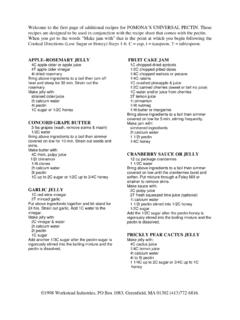Transcription of Fermentation of Apple Juice to Cider - bashaar.org.il
1 Fermentation of Apple Juice to Cider Introduction Fermentation has been utilized for many years in the preparation of beverages. Materials from Egyptian tombs demonstrate the procedures used in making beer and leavened bread. The history of Fermentation , whereby sugar is converted to ethanol by action of yeast, is also a history of chemistry. Van Helmont coined the word gas in 1610 to describe the bubbles produced in Fermentation . Leeuwenhoek observed and described the cells of yeast with his newly invented microscope in 1680. Joseph Black discovered carbon dioxide and showed it to be a product of Fermentation in 1754. Lavoisier in 1789 showed that fermenting sugar produces ethanol and carbon dioxide, and he made quantitative measurements of the amounts consumed and produced [1]. In 1815, after the mole concept was established, Gay-Lussac showed that one mole of glucose produces exactly two moles of ethanol and two moles of carbon dioxide.
2 But the process of Fermentation puzzled some great chemists. Kutzing wrote in 1837, It is obvious that chemists must now strike yeast off the role of chemical compounds, since it is not a compound but an organized body, an organism. And then there were chemists such as Berzelius, who believed that yeast had a catalytic action [1]. It remained for Pasteur to show that Fermentation was a physiologic action associated with the life processes of yeast. In his classic paper of 1857, he described Fermentation as the action of a living organism. However, other chemists disputed his findings because the conversion of glucose to ethanol and carbon dioxide is a balanced equation. So a search was begun to find the substance in yeast that might cause the reaction. It took 40 years before a clever experiment by Eduard Buchner ended the search. He made a cell-free extract of yeast that still caused the conversion of sugar to alcohol. This cell-free extract contained the catalysts, which we now call enzymes, that are necessary for Fermentation .
3 This discovery earned Buchner the 1907 Noble Prize. In 1905 Harden discovered that inorganic phosphate, added to the enzymes, increased the rate of Fermentation and was also consumed itself. This result led to the isolation of many other types of sugars. Clearly, the history of biochemistry is closely associated with the study of alcoholic Fermentation [1]. Ancient peoples discovered many of the essential reactions of alcoholic Fermentation completely by accident. How did they discover that the starch of wheat or barley could be converted to sugar by the enzymes in malt? When grain germinates, enzymes are produced that turn the starch into sugar. The process of malting involves letting the grain start to germinate and then heating and drying the sprouts to stop the process before the enzymes are used up. The color of the malt depends on the temperature of the drying. The darkest is used for stout and porter, the lighter, for brown, amber, and pale ale.
4 At some point hops were added to beer due to a discovery that the resulting beverage does not spoil so rapidly [1]. The process of Fermentation is used to make products far more important than food or drinks. Fermentation products have both industrial and medicinal applications. Penicillin, other antibiotics, and riboflavin vitamins are all created by Fermentation . Citric acid created by Fermentation is used in metal cleaners and in food preservation. This acid is naturally occurring in citrus fruits, but getting it directly from the fruits is uneconomical. By fermenting molasses, you can get the same acid cheaply and efficiently. Different Fermentation processes are used depending on the product. Some forms of Fermentation are naturally occurring. That is, the yeast, mold, or bacteria is already in the reactant. In other situations the ferment, that is the yeast, mold, or bacteria, must be carefully added under specific conditions.
5 But what happens is always the same. The sugar molecules in the substance are converted to something else, such as alcohol, or lactic acid. In this experiment alcoholic Fermentation will be explored through the production of Cider . The production of Cider is rather simple. First, if preparing the Cider by traditional methods, the apples must be picked and aged for a week. The apples are then crushed using a Cider press to collect the Juice . The freshly pressed Juice is then fermented immediately by placing in a wooden barrel and allowing wild yeast to ferment the Juice . The Fermentation starts in 1-2 days and continues for several weeks, during which time the barrel is topped off with more Juice . Once Fermentation is over, the barrel is sealed and matured for 5-6 months [2]. This traditional Cider is often served completely flat and may be cloudy. It may also be served as a naturally conditioned cask Cider , analogous to a real ale.
6 In France, Cider is produced by the Charmat process (often used to produce sparkling wines) and is highly carbonated and more like an Apple wine than traditional English Cider [2]. The Cider in this experiment will be prepared by a more commercial operation in which a pasteurized Juice is taken and fermented using specific yeast. In this case dry wine yeast will be used, which produces what is considered a Normandy style Cider . Experimental First clean and dry a 125-ml Erlenmeyer flask. Weigh the flask. To the empty, clean flask add 50 ml of room temperature Apple Juice using a 50 ml graduated cylinder. Now add several grains of dry wine yeast to the flask; be sure there are at least 5 grains. Using an analytical balance that reads to 200 grams, obtain the mass of the flask containing the Juice and yeast. Once this is done, place a 9-inch helium quality balloon over the top of the flask, making sure the balloon stretches approximately 1 inch down the neck of the flask.
7 Now place a bag tie or rubber band tightly around the neck of the flask to seal the balloon on the flask. Let the apparatus set for 1 week undisturbed. After 1 week the Fermentation should be complete. The balloon should now be inflated to some extent. This is due to the formation of carbon dioxide in the process of Fermentation . A procedure for the determination of the volume of gas collected in the balloon now needs to be devised. Some of the items that can be used in this process are a 600-ml beaker, 50-ml beaker, 50 ml graduated cylinder, and a 6-inch test tube. An inverted vessel, full of water, works well in the collection of small volumes of gas. Once the volume of gas has been collected, the flask which now contains Cider needs to be re-weighed. You will notice that the mass is now smaller than the starting mass. One product, carbon dioxide gas was released, thereby causing a decrease in mass of solution. This mass will be used to calculate the % mass of alcohol in the solution.
8 The volume of gas collected through the devised procedure will also be used to calculate a separate % mass alcohol. A comparison of these two measurements will be made and discussed as a group. Summary of Procedure 1) Weigh a clean 125-ml Erlenmeyer flask. 2) Place 50-ml of Apple Juice and grains of dry wine yeast in flask. 3) Weigh the flask containing the Juice and yeast. 4) Place a helium balloon on top and seal with a rubber band or bag twist. 5) Let sit for one week 6) Determine the volume of gas collected in the balloon. 7) Weigh the flask containing the Cider . 8) Calculate % mass of alcohol in the Cider . Calculations The ideal gas law can be used to calculate moles of a gas from a given volume of the gas at a specific temperature and pressure. The ideal gas law is: PV = nRT Where P is the pressure in atmospheres, V is the volume in liters, n is the number of moles, T is the temperature in Kelvin, and R is the ideal gas constant 0 K FHGIKJ.
9 First, solve for moles of gas. nPVRT= To calculate the mass of ethanol from the moles of carbon dioxide, you must use the mole ratio from the balanced equation. C6H12O6 yeast 2 CH3CH2OH + 2 CO2 To calculate the percent by mass of ethanol in your Cider , divide the grams of ethanol by the final mass of solution and multiply by 100. grams ethanolgrams cidermass ethanol =100% Fermentation Report Sheet Pre-lab Questions 1) What is the balanced equation for alcoholic Fermentation ? 2) If a 50-mL sample of Apple Juice contains grams of glucose, how many grams of ethanol is produced at the end of Fermentation assuming complete reaction? What % mass of ethanol is in the solution if the initial mass of solution is grams? 3) From the question above, what is the theoretical yield of carbon dioxide (in grams) and what volume will the gas occupy at a pressure of 598 mmHg and a temperature of C? Procedure for Measurement of Gas Collected Experimental Results Mass of Empty Flask (g) Mass of Flask, Apple Juice , and Yeast (g) Starting Mass of Apple Juice and Yeast (g) Final Mass of Flask and Cider (g) Mass of Cider (g) Mass of CO2 Produced (g) Mass of ethanol from mass of CO2 (g) Volume CO2 Collected (ml) Mass of CO2 From Volume of CO2 (g) Mass of ethanol from volume (g) % Mass Ethanol from CO2 Mass % Mass Ethanol from CO2 Volume Discussion of Results Comments and Suggestions for This Lab References 1) Williamson, Kenneth.
10 Macroscale and Microscale Organic Experiments. 2nd Ed. Heath and Company. 1994, 594-604. 2) Cider making. [Online] Available.







